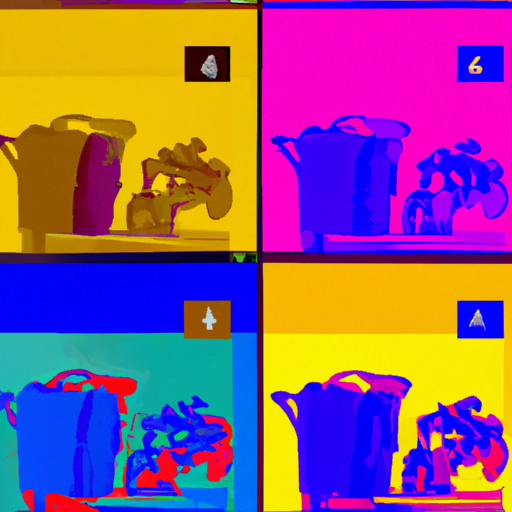
-
Table of Contents
- Dynamic Color Schemes: Using AI to Adapt Designs in Real Time
- The Power of Dynamic Color Schemes
- AI-Powered Color Adaptation
- User Preferences
- Environmental Conditions
- Real-Time Data Analysis
- Case Studies
- Spotify’s Dynamic Album Art
- Philips Hue Smart Lighting
- The Future of Dynamic Color Schemes
- Conclusion
Dynamic Color Schemes: Using AI to Adapt Designs in Real Time

Colors play a crucial role in design, evoking emotions, setting moods, and influencing user experiences. Traditionally, designers have manually selected color schemes for their projects, but with the advancements in artificial intelligence (AI), dynamic color schemes are becoming a reality. By leveraging AI algorithms, designers can now create designs that adapt and change color in real time, enhancing user engagement and personalization. In this article, we will explore the concept of dynamic color schemes and how AI is revolutionizing design.
The Power of Dynamic Color Schemes
Dynamic color schemes refer to designs that can automatically adjust their colors based on various factors such as user preferences, environmental conditions, or even real-time data. This adaptability allows designs to be more responsive and personalized, creating a unique experience for each user. Here are some key benefits of using dynamic color schemes:
- Enhanced User Engagement: Dynamic color schemes can captivate users by providing visually appealing and interactive experiences. By adapting colors to match user preferences or real-time data, designs can create a sense of personalization and make users feel more connected to the content.
- Improved Accessibility: Color plays a vital role in accessibility, especially for individuals with visual impairments or color blindness. Dynamic color schemes can automatically adjust colors to ensure optimal contrast and readability, making designs more inclusive and accessible to a wider audience.
- Increased Brand Consistency: Brands often have specific color palettes that represent their identity. With dynamic color schemes, designs can adapt the color palette while maintaining brand consistency. This flexibility allows brands to experiment with different color combinations without compromising their visual identity.
- Real-Time Data Visualization: Dynamic color schemes can be particularly useful in data visualization, where colors can represent different data points or trends. By adapting colors based on real-time data, designers can create visually engaging and informative representations of complex information.
AI-Powered Color Adaptation
The implementation of dynamic color schemes relies on AI algorithms that can analyze various inputs and adapt the colors accordingly. These algorithms can be trained using machine learning techniques to understand user preferences, environmental conditions, or any other relevant data. Here are some examples of how AI can power color adaptation:
User Preferences
AI algorithms can learn from user interactions and preferences to create personalized color schemes. By analyzing user data such as browsing history, previous color choices, or even physiological responses, AI can generate color combinations that resonate with individual users. For example, a website can adapt its color scheme to match a user’s favorite color or create a calming environment based on their stress levels.
Environmental Conditions
Dynamic color schemes can also adapt to environmental conditions such as time of day, weather, or location. AI algorithms can analyze real-time data from sensors or APIs to adjust colors accordingly. For instance, a mobile app can change its color scheme to warmer tones during sunset or display different colors based on the weather conditions at the user’s location.
Real-Time Data Analysis
In data visualization, AI algorithms can analyze real-time data and assign colors based on the values or trends being represented. For example, in a stock market visualization, colors can change dynamically to represent the rise or fall of stock prices. This real-time color adaptation enhances the understanding and interpretation of complex data.
Case Studies
Several companies and designers have already embraced dynamic color schemes powered by AI. Let’s explore a few case studies that demonstrate the effectiveness of this approach:
Spotify’s Dynamic Album Art
Spotify, the popular music streaming platform, introduced dynamic album art that adapts its colors based on the album’s genre and mood. Using AI algorithms, Spotify analyzes the audio features of each song and generates a color palette that reflects the mood and genre of the music. This dynamic color adaptation enhances the visual experience of browsing through albums and creates a more immersive connection between the user and the music.
Philips Hue Smart Lighting
Philips Hue, a leading smart lighting system, utilizes dynamic color schemes to enhance the ambiance of a room. By integrating with AI assistants like Amazon Alexa or Google Assistant, users can control the lighting color and intensity using voice commands. Additionally, the system can adapt the lighting colors based on the time of day or user preferences, creating personalized and dynamic lighting experiences.
The Future of Dynamic Color Schemes
The potential of dynamic color schemes powered by AI is vast, and we can expect to see further advancements in this field. Here are some potential future developments:
- Emotion-Based Color Adaptation: AI algorithms can be trained to analyze facial expressions or physiological responses to determine the user’s emotional state. By understanding emotions, designs can adapt their color schemes to create environments that promote relaxation, focus, or excitement.
- Contextual Color Adaptation: AI algorithms can analyze contextual information such as the content being displayed or the purpose of the design. For example, a news website can adapt its color scheme to match the seriousness of the news article or a gaming interface can adjust colors based on the game genre.
- Collaborative Color Adaptation: AI algorithms can learn from user feedback and preferences to create collaborative color schemes. By analyzing the preferences of a group of users, designs can adapt colors that are appealing to the majority or create a compromise between different preferences.
Conclusion
Dynamic color schemes powered by AI are revolutionizing the design industry. By leveraging AI algorithms, designers can create designs that adapt and change color in real time, enhancing user engagement, personalization, and accessibility. The ability to analyze user preferences, environmental conditions, and real-time data allows designs to create unique and immersive experiences. As AI continues to advance, we can expect even more exciting developments in the field of dynamic color schemes, enabling designers to create visually stunning and personalized designs.
